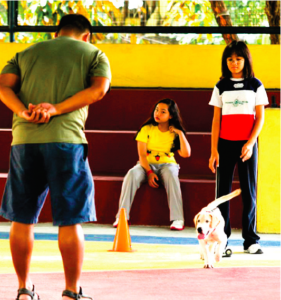You have to take that leap into the sometimes challenging but ultimately rewarding world of responsible pet ownership: introducing your puppy to your home and establishing routines that will help keep your puppy healthy, safe, and loved.
Is this easier said than done?

Canine behavior consultant and veterinarian Dr. Marose Magpily says that while puppies are naughty by nature, training and supervision in the early stages of its life can ensure that your unruly puppy will grow up to be a well-behaved dog. “All puppies frequently test your rules and boundaries: they make messes, they destroy things, they eat things they’re not supposed to eat,” says Magpily.
”What every new puppy owner should aim for is to have a well-managed puppy – meaning that repetitions of bad behavior should be prevented. [The puppy should also be] frequently exposed to controlled socialization and early basic obedience training.”
Doc Marose knows whereof she speaks. A graduate of canine behavior science programs in the United States and Canada―and herself the owner of two dogs, a Labrador-Golden Retriever cross named Ollie and Tramp, a schnauzer mix―she helps owners housetrain their puppies through behavior consultations and training classes at her Quezon City-based vet practice, Pet Centrics. We asked her what home manners are required learning for new puppies, and she gave us a few pointers on how first-time owners can manage basic training:
IMPULSE CONTROL: Puppies should know that it can’t just lunge for and grab things they want unless given permission to do so. This applies to the three Fs: food, fun, and freedom.
Teaching tip: Keep the 3 Fs safely out of reach and prevent access to these until the puppy “asks” for it nicely. Teach a puppy to do an automatic sit as its way of saying “please.”

SETTLING DOWN IN A CRATE/ALONE TIME: Puppies should learn to settle down and to be calm and quiet when crated, and to wait for attention to be given instead of demanding for it.
Teaching tip: Teach your puppy to enjoy going inside the crate by frequently feeding it treats while inside. Slowly increase its crating period to a maximum of 4 hours. Make sure that the puppy has had an opportunity to go potty and exercise before being crated.
CHEW TOY TRAINING: Puppies should be taught to chew on appropriate chew items.
Teaching tip: Select appropriately-sized, durable chew toys; those that can be stuffed with dog food or treats are highly recommended and useful for crate training and alone training. As the puppy is engaged with the chew toy, the chewing behavior is rewarded by the treats that fall out of the toy. Note that the treats inside the toy are not extra snacks: these should be taken from your puppy’s daily meal ration.
ACCEPTING HANDLING: Puppies should learn to accept handling by people other than their owner, such as vets, groomers, and other pet professionals.

Teaching tip: Condition the puppy to accept handling by pairing any handling activities with treats. Synchronize touch with giving treats to the mouth. If you repeat this frequently and in various handling scenarios such as nail clipping, coat brushing, and basic vet exams, the puppy will learn to not only tolerate handling but to enjoy it.
POTTY TRAINING: Puppy should do its business in the appropriate spot.
Teaching tip: A puppy’s first order of business is to, well, do its business. Take it directly to its potty spot whenever you let it out of its confinement area. Praise and reward him with a treat when he gets the job done. If he does otherwise, take him back inside and repeat the process after fifteen to twenty minutes. Only puppies with empty bladders and bowels are allowed free time outside their confinement areas or crates. Constant vigilance is key: puppies may have ‘accidents’ without supervision.

LEASH MANNERS: While leash walks are not recommended until a puppy has completed its vaccination regimen, puppies can already be introduced to wearing a collar and leash.
Teaching tip: Pick a lightweight leash and collar. While indoors, let your puppy drag the leash around while you engage it in simple training exercises such as ‘sits’, ‘downs’, and ‘following’ games. This helps it associate leash time with fun and games.It is important to remember to level your expectations during training. Dogs may be highly trainable animals, but some breeds are more receptive than others, and every dog is different. Adjust your training to match your puppy’s attention span, learning pace, and intelligence, and this can be the start of a long and happy friendship.
This appeared as “Doggie Deportment” in Animal Scene’s January 2016 issue.






